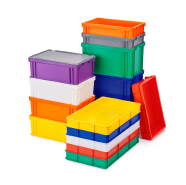Materials
handling bins, trucks, trays, dispensers and tanks perform many functions in
food production – moving, sorting, collecting and storing anything from
ingredients, seasonings and finished product right through to waste material.
Here are 5 tips to make sure you choose the product that is best suited for your application.
Here are 5 tips to make sure you choose the product that is best suited for your application.
-

1. Injection moulded or roto moulded?
These are the two different moulding processes used to produce the majority of plastic food contact approved storage containers.Injection moulding is when preheated polymer is injected under pressure into moulds, which then open to release the formed article. This process is commonly used for trays and crates. It is quick and efficient, resulting in lower costs per unit, however it is not as robust as roto-moulded items – particularly when comparing larger items such as trucks and tanks.In contrast, roto moulding involves placing polymer granules inside a heated mould tool. This mould is rotated, and as the granules melt they are evenly distributed on the inside surface of the mould, becoming smooth and solid when cooled. The production process is slow – hence unit costs are higher – but the final product is extremely durable and makes for a much longer life. For the rigours of production, storage and waste disposal, roto-moulded plastic items soon show excellent returns on initial outlay due to their inherent strength.
-

2. What sizes do you actually require?
Roto-moulding enables larger sizes of bins, trucks and tanks to support the weight of the contents. For example, the largest roto-moulded food grade truck is 625 litres!Give careful consideration to bin capacity, as typically solids in production are measured by weight, whereas all materials handling bins, trucks and tank capacities are in litres.Volumetric requirements of different products vary greatly – for example, 25kg of water and 25kg of offal will need significantly different size bins or trucks.
-

3. What chemicals will your storage containers be in contact with?
Animal fats and cleaning chemicals are notorious for breaking down the molecular structure of plastics, causing potential breakages and foreign body risks.Before purchasing, always make sure that the truck, trolley, dispenser or bin you are considering are resistant to the chemicals you use on site or to any by-products derived from the process.Full compliance and materials data on Klipspringer’s range of food grade containers can be viewed here.
-

4. How durable is your colour?
To avoid the risk of colour fade, check that all colouration used in your trucks and tanks are UV stable.Maintaining colour distinction, particularly when working with orange, yellow and red, for example, is vital for correct identification. If you are handling strong-coloured sauces or ingredients, we would recommend running an on-site trial first for a suitable period.All colour additives used in the roto-moulded polymers are stable and food contact approved.
-

5. What are the optimum quantities you will require?
Due to manufacturing methods, economies of scale apply. It is well worth the time estimating your proposed usage over 6 or 12 months in order to obtain the best unit price.Consolidation of requirements rather than frequent smaller purchases will definitely be a benefit from a cost-saving point of view, whilst ensuring you obtain a consistent and quality range of containers across your site.










